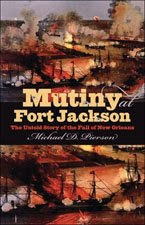 Mutiny at Fort Jackson; The Untold Story of the Fall of New Orleans. Michael D. Pierson, University of North Carolina Press,264 pp., 27 illustrations, notes, bibliography, index, Winter 2008-2009.
Mutiny at Fort Jackson; The Untold Story of the Fall of New Orleans. Michael D. Pierson, University of North Carolina Press,264 pp., 27 illustrations, notes, bibliography, index, Winter 2008-2009. New Orleans was the largest city--and one of the richest--in the Confederacy, protected in part by Fort Jackson, which was just sixty-five miles down the Mississippi River. On April 27, 1862, Confederate soldiers at Fort Jackson rose up in mutiny against their commanding officers. New Orleans fell to Union forces soon thereafter. Although the Fort Jackson mutiny marked a critical turning point in the Union's campaign to regain control of this vital Confederate financial and industrial center, it has received surprisingly little attention from historians. Michael Pierson examines newly uncovered archival sources to determine why the soldiers rebelled at such a decisive moment.
The mutineers were soldiers primarily recruited from New Orleans's large German and Irish immigrant populations. Pierson shows that the new nation had done nothing to encourage poor white men to feel they had a place of honor in the southern republic. He argues that the mutineers actively sought to help the Union cause. In a major reassessment of the Union administration of New Orleans that followed, Pierson demonstrates that Benjamin "Beast" Butler enjoyed the support of many white Unionists in the city.
Pierson adds an urban working-class element to debates over the effects of white Unionists in Confederate states. With the personal stories of soldiers appearing throughout, Mutiny at Fort Jackson presents the Civil War from a new perspective, revealing the complexities of New Orleans society and the Confederate experience.
About the Author
Michael D. Pierson is associate professor of history at the University of Massachusetts, Lowell. He is author of Free Hearts and Free Homes: Gender and American Antislavery Politics (from the University of North Carolina Press).
Blurbs:
"Pierson shows that there is much more to the Fort Jackson mutiny than we have thought, and that it really matters historically. He not only analyzes the episode astutely and provides rich background material, but also tells a good story, replete with drama and even humor. This is a well-written, well-organized, and deeply researched study that has important implications for some of the major issues currently being debated among Civil War historians."
--Stephen V. Ash, author of When the Yankees Came: Conflict and Chaos in the Occupied South
"Mutiny at Fort Jackson makes a significant, original contribution to the field of Civil War history. Identifying the home front as crucial to understanding the course of the Civil War and its impact on American society, Pierson expands the burgeoning study of Southern Unionism with a sophisticated analysis of Unionism in New Orleans's ethnically diverse, urban wage economy. This book will interest Civil War enthusiasts as well as students and scholars."-Victoria Bynum, author of The Free State of Jones: Mississippi's Longest Civil War
 Ghost town - Fort Jackson, LA. This old American military post was located on SH 23, and the west bank of the Mississippi River, 2.5 miles southeast of Triumph, about 70 miles southeast of New Orleans. It was built in 1822-1832, and occupied in 1861 by the Confederate Army. It is a large, star-shaped brick fort with a surrounding moat. It was built to protect New Orleans, but on April 18, 1862, Admiral Farragut and his fleet of 43 boats, battled the fort for over a week. New Orleans fell, the fort surrendered, and his forces occupied them. Since 1961, Fort Jackson has been a National Historic Monument. Closed since Katrina.
Ghost town - Fort Jackson, LA. This old American military post was located on SH 23, and the west bank of the Mississippi River, 2.5 miles southeast of Triumph, about 70 miles southeast of New Orleans. It was built in 1822-1832, and occupied in 1861 by the Confederate Army. It is a large, star-shaped brick fort with a surrounding moat. It was built to protect New Orleans, but on April 18, 1862, Admiral Farragut and his fleet of 43 boats, battled the fort for over a week. New Orleans fell, the fort surrendered, and his forces occupied them. Since 1961, Fort Jackson has been a National Historic Monument. Closed since Katrina.Text: http://uncpress.unc.edu/browse/book_detail?title_id=1549
Photograph and Caption: http://picasaweb.google.com/khokhloma/NewOrleans/photo#5137372912340959682
No comments:
Post a Comment